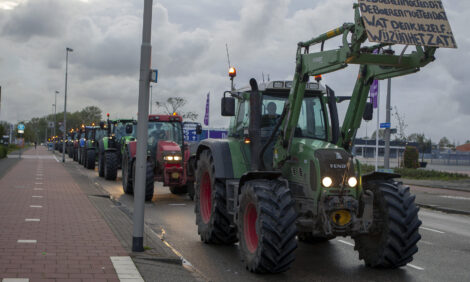



NFUS Links With Kenyan Farming Community
KENYA - A delegation from NFU Scotland is in Kenya to view first hand the challenges that face pastoral farming and agriculture in the country and identify if the Union can contribute to ongoing improvements to farming in the region in the future. NFU Scotland Vice President Allan Bowie and Chief Executive James Withers are spending six days looking at agriculture and farming in the Laikipia and Samburu districts of northern Kenya. As part of the visit, they will give consideration to NFUS supporting a possible project in the area to tie in with the Union’s centenary in 2013.
Speaking from the Ol Pejeta Conservancy, James Withers said: “People may rightly ask the question: what business does a Scottish agricultural membership organisation have in Africa? The answer is that we want to create a lasting relationship between two farming communities on different continents as a fitting way to mark our centenary in 2013.
“It is already clear that there are many projects here that would merit out support - from community initiatives to water storage and irrigation to the building of a 'learning and development centre' to develop the management capacity within local communities. This journey that the Union has started has the potential to sow the seed of a relationship between agricultural communities in this country and back home.
“We have a week of intense visits to try and get a handle on the many challenges for producers here in northern Kenya and where NFUS could have a role as a catalyst for development and capacity building - crucially by linking in to existing networks and projects.
“As an example of good work already underway, we visited Ol Pejeta Conservancy. Spanning over 350 square kilometres, it has pioneered a new form of conservation in Africa where it believes big game wildlife and livestock can achieve a balance. So their 6000 head of Boran cattle live alongside some 80 lions, 120 rhinos, 300 elephants, cheetahs and countless other species. The balance is not an easy one and the manager of the livestock enterprise has to get used to losing at least 5 cattle a month to predation.
“Crucially, they have learnt what we have in Scotland - that grazing cattle enrich habitats and underpin valuable wildlife populations. Whilst there are tensions, the ecosystem is richer for the presence of well-managed stock. And the earnings from both cattle-rearing and tourism are reinvested with a single clear focus of community development. Ol Pejeta is surely a model for other conservancies to follow.
“Allan and I are looking forward to reporting back to the Union board and our members the findings of our trip. While the shape of any future NFUS project has yet to be decided, it is clear that it could make a difference and enrich the lives of agricultural communities who may be divided across two continents, but could come a lot closer together for everyone's benefit.”
TheCattleSite News Desk


